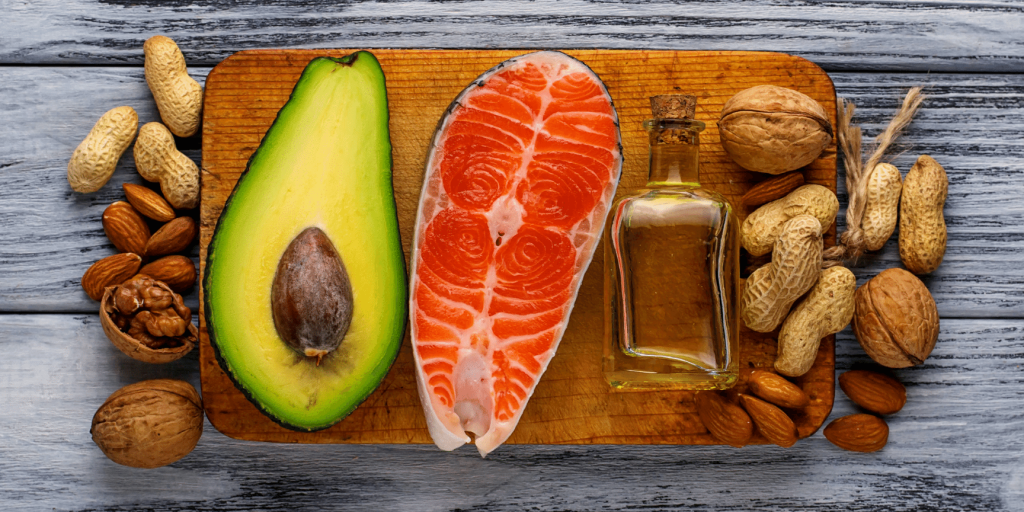Dietary fat – are all fats unhealthy?

The word ‘fat’ is not uncommonly feared by people who are struggling with overweight or obese and want to lose weight. But is fat, in fact, so scary in a reduction diet? Well, no! What’s more, fat is a very important component of the diet, and its presence is essential for the body to function properly and carry out metabolic processes.
Why do we need fat in our diet?
Next to carbohydrates, fats are the main source of energy in the human body. In addition, they are the carrier of fat-soluble vitamins (A, D, E, K), are incorporated into cell membranes and participate in the synthesis of hormones. They are essential for the normal development of the neural tube in children during the prenatal period. However, it is important to remember that although all types of fats provide the same amount of energy to our body, in terms of beneficial effects on the body, they are not all equal.
Dietary fat: animal
Animal fats (of which animal products are a source) are rich in saturated fatty acids. A small amount of these in the diet, will not have an adverse effect on health, whereas an excess can contribute to the development of atherosclerosis. This in turn can lead to heart attack, stroke or the development of other cardiovascular diseases. Animal fats are also rich in cholesterol (with a predominance of its LDL fraction), excessive consumption of which, like saturated fatty acids, can also contribute to the development of atherosclerosis. Among animal products, fatty fish are an exception, as they are a source of unsaturated fatty acids, including omega-3 and omega-6, which have a very beneficial effect on the body. Therefore, fish such as salmon, herring or anchovy are invaluable ingredients in dishes that will ensure healthy fat in the diet.
Dietary fat: vegetable
Vegetable fats are abundant in unsaturated fatty acids, which have a far more beneficial effect on health. Therefore, the need for them is greater than for saturated fatty acids. Unsaturated fatty acids can be divided into monounsaturated and polyunsaturated (e.g. omega-3 and omega-6). Although each of the above-mentioned groups of fatty acids has a slightly different role, it can generally be said of them that they have a positive effect on lipid metabolism. Among other things, they contribute to lowering cholesterol levels (total and LDL fractions) and triglycerides and increasing the HDL fraction of cholesterol. In addition, unsaturated fatty acids have an antioxidant effect, which is an important issue in the prevention of chronic diseases and cancer.
Products that are a source of fats in the diet
| Monounsaturated fatty acids | Polyunsaturated fatty acids | Saturated fatty acids |
| Olive oil | Fatty fish (e.g. salmon) | Meat (e.g. pork, beef) |
| Canola oil | Linseed oil | Lard |
| Nuts and seeds (e.g. walnuts, hazelnuts, almonds, pumpkin seeds) | Cod liver oil | Dairy products (e.g. butter, fat cottage cheese, milk, cheese) |
Dietary fat: trans
Trans fats are monounsaturated fatty acids, with a trans-type structure. They are formed by the hydrogenation, or hardening, of vegetable fats. Trans fats are mainly found in margarine used for baking, confectionery (e.g. cakes, biscuits), deep frying, fast food and crisps. Hydrogenated fats have a similar effect on the body as saturated fatty acids, raising cholesterol levels and contributing to the development of atherosclerosis and cardiovascular disease. It cannot, therefore, be said to be healthy dietary fat.
Dietary fat requirements
The dietary fat requirement of an average adult should be 25-30% of the daily energy requirement (CPM). It is recommended that its main source should be monounsaturated fatty acids at 15-20% of the total energy provided during the day. Polyunsaturated fatty acids should make up 6-11% of CPM and saturated fatty acids no more than 10% of CPM. The intake of trans fats must not exceed 1% of the total energy provided during the day.
How to control the intake of the different types of fat?
To control the intake of the above-mentioned types of fat, it is useful to use an app that is a calorie calculator, such as the Fitatu app. In the extensive nutrient intake summary, you will not only find information on protein, fat, and carbohydrate intake, but also information on specific types of fat (saturated, monounsaturated, polyunsaturated, omega 3, omega 6), as well as vitamins and minerals. Unfortunately, due to the lack of an obligation to provide data on the content of all nutrients on food packaging, it is often not possible for the summary to reflect the daily intake of these nutrients 100%, but it will certainly help to estimate the amount.
Fitatu App
Download the application from the Play Store or Apple Store and start counting your macros with us!
Do you prefer the web version? No problem. A basic web version is prepared for our subscribers. And now you can use the FAT-C discount code by going to https://www.fitatu.com/app/order-and-payment and get 29% off your monthly Fitatu Premium.
What else can you find in Fitatu Premium?
- over 2000 recipes plus several new ones every month
- additional plans for intermittent fasting
- the ability to create shopping lists
- a choice of six ready-made menus full of meals to choose
- filtering products and recipes
- more synchronization with fit apps
- access to your Meal Plan in the web version
- no ads!
Bibliography:
- Ciborowska H., Rudnicka A., „Dietetyka żywienie zdrowego i chorego człowieka”, PZWL Warszawa 2014 r.
- Gawęcki J., „Żywienie człowieka Podstawy nauki o żywieniu”, PWN Warszawa 2012 r.
- https://www.who.int/news-room/fact-sheets/detail/healthy-diet





